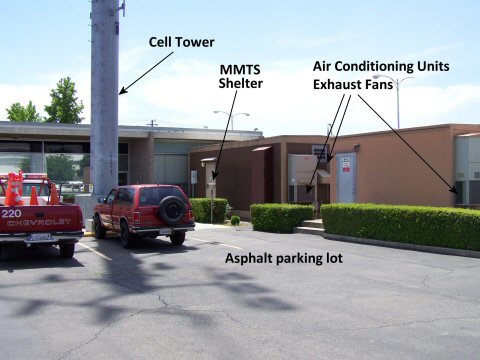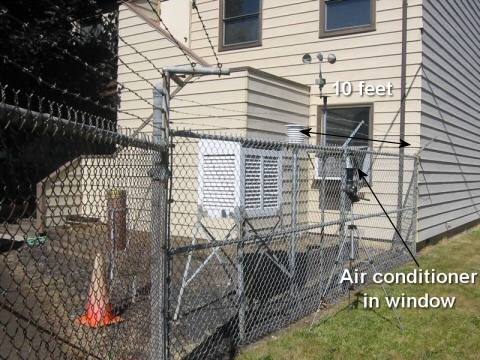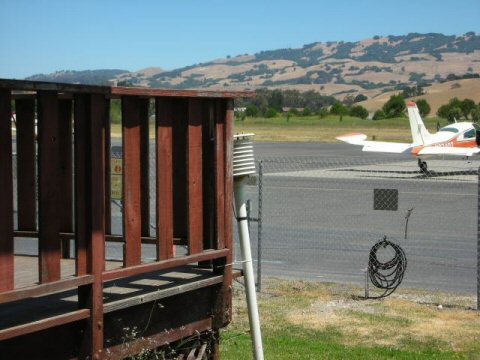Does this Make Sense?
I am just finishing up my paper "A Skeptical Layman's Guide to Anthropogenic Global Warming," and one thing I encounter a lot with sources and websites that are strong supporters of Anthropogenic Global Warming (AGW) theory is that they will often say such-and-such argument by skeptics was just disproved by so-and-so.
For example, skeptics often argue that historical temperature records do not correct enough for the effects of urbanization on long-term measurement points. The IPCC, in fact, has taken the position that what is called the urban heat island effect is trivial, and does not account for much or any of measured warming over the last 100 years. To this end, one of the pro-AGW sites (either RealClimate.org or the New Scientist, I can't remember which) said that "Parker in 2006 has disproved the urban heat island effect."
Now, if you were going to set out to do such a thing, how would you do it? The logical way, to me, would be to draw a line from the center of the city to the rural areas surrounding it, and take a bunch of identical thermometers and have people record temperatures every couple of miles along this line. Then you could draw a graph of temperature vs. nearness to the city center, and see what you would find.
Is that what Parker did? Uh, no. I turn it over to Steve McIntyre, one of the two men who helped highlight all the problems with the Mann hockey stick several years ago.
If you are not a climate scientist (or a realclimate reader), you
would almost certainly believe, from your own experience, that cities
are warmer than the surrounding countryside - the "urban heat island".
From that, it's easy to conclude that as cities become bigger and as
towns become cities and villages become towns, that there is a
widespread impact on urban records from changes in landscape, which
have to be considered before you can back out what portion is due to
increased GHG.One of the main IPCC creeds is that the urban heat island effect has
a negligible impact on large-scale averages such as CRU or GISS. The
obvious way of proving this would seem to be taking measurements on an
urban transect and showing that there is no urban heat island. Of
course, Jones and his associates can't do that because such transects
always show a substantial urban heat island. So they have to resort to
indirect methods to provide evidence of "things unseen", such as Jones
et al 1990, which we've discussed in the past.The newest entry in the theological literature is Parker (2004, 2006),
who, once again, does not show the absence of an urban heat island by
direct measurements, but purports to show the absence of an effect on
large-scale averages by showing that the temperature trends on calm
days is comparable to that on windy days. My first reaction to this,
and I'm sure that others had the same reaction was: well, so what? Why
would anyone interpret that as evidence one way or the other on UHI?
He goes on to take the study apart in detail, but I think most of you can see that the methodology makes absolutely zero sense unless one is desperately trying to toe the party line and win points with AGW supporters by finding some fig leaf to cover up this urban heat island problem. By the way, plenty of people have performed the analysis the logical way we discussed first, and have shown huge heat island effects:
The bottom axis by the way is a "sky-view" metric I had not seen before, but is a measurement of urban topology. Effectively the more urbanized and the more tall buildings around you that create a canyon effect, the lower the sky view fraction. Note that no one gets a number for the Urban Heat Island effect less than 1 degree C, and many hover around 6 degrees (delta temperature from urban location to surrounding rural countryside). Just a bit higher than the 0.2C assumed by the IPCC. Why would they assume such a low number in the face of strong evidence? Because assuming a higher number would reduce historical warming numbers, silly.
Oh, and the IPCC argues that the measurement points it uses around the world are all rural locations so urban heat island corrections are irrelevant. Below are some sample photos of USHCN sites, which are these supposedly rural sites that are used in the official historical warming numbers. By the way, these US sites are probably better than what you would find anywhere else in the world. (All pictures from surfacesations.org) As always, you can click for a larger view.
You can help with the effort of documenting all the US Historical Climate Network (USHCN) stations. See my post here -- I have already done two and its fun!





Okay,maybe some temperature measures are misleading. But, if simply changing the landscape can have such a local effect, it also adds to a global effect. Maybe global warming data is due at least in part to the urban heat island. Which is another way of saying that now, besides CO2, we also have an albedo problem. Cities absorb more sunlight and heat up more. We still have a global warming problem, and our homes, businesses and roads are part of it. Truth is, the big worry is albedo. Because as glaciers shrink, snow melts quicker and ice pack disappears in the Arctic Ocean, the color of the planet earth gets distinctly darker. If cities local temperatures can go up six degrees over the surroundings, what happens when an area the size of a continent goes from shiny white to the color of bare rock, or open ocean?
In the early 1990's I helped install several Automated Weather Observation Stations (AWOS) at airports in Western Pennsylvania. These stations were put in locations designed to minimize the conditions that are shown in your photographs. I know that these stations were placed all over the US. I wonder what the data from these stations shows for the last 10 years?
"By the way, these US sites are probably better than what you would find anywhere else in the world." Why do you think so?
Actually, a study comparing rural to urban weather stations measurements has been done by NASA GISS and NOAA who examined the last century of temperature data across the USA and found any possible urban warming was small and fell within uncertainty ranges. When attempting to correct urban levels to match surrounding rural levels, they found 42% of cities were getting cooler relative to their surroundings as weather stations are often sited in cool islands (eg - a park within the city). The point is NASA GISS are very aware of any possible Urban Heat Island effect and remove any spurious signals by normalizing urban stations to surrounding rural stations. Any stations with irreconcilable data are dropped.
Was pointed to your post by Richard Nikoley, after I posted on this subject, noting a retired meteorologist's questioning of station data at my site. Maybe I'll step up and see if some of the Michigan stations get documented. Thanks.
JC
Wouldn't your 42% prove Coyotes' point indirectly? In other words, the parks are getting cooler relative to the surrounding city because the surrounding city is warming up.
Xalem
I can't quite buy your implicit positive feedback effect (albedo driven by temperature changes causes more temperature change, downward death spiral). If that mechanism existed, Earth would've already death-spiraled. Because massive events (large meteorite impacts, etc.) have knocked the earth way off of where we are today...and we returned here, the Earth's temperature mechanism *must* be a negative feedback system.
Temperature goes up for whatever reason, something changes to drive it back down. I don't have to know the mechanism to know that it works that way.
If it were a positive feedback system, temperature goes up for whatever reason, (insert favorite mechanism, perhaps glaciers melt, changes albedo, maybe CO2 bubbles out of ocean, whatever--doesn't matter), temperature goes up even more, more mechanism, more temp. increase, etc., and suddenly we're all Venus-like.
That hasn't happened in hundreds of millions of years despite massive events, temperature excursions, etc. Ergo, not a positive feedback system.
Ultimately the issue is bias in measurements. A basic principle of stats and all measurement science is if you can not conduct a census (measure or count every member of the population) then the sample you take must be selected at random.
Clearly the permanent weather stations are not located in random places. To your point many are biased to measure temperature in cities (or near air conditioners) or other convenient areas.
This is typical of what I call 'beauracratic science; we can not afford to do it correctly so we'll 'adjust' the numbers in the end to make up for our schlocky approach.
To another point, how many of the world's temperature measuring stations are routinely calibrated? I think I know the answer; few if any.
I trust land based temperature measurements about as much as I trust single point sea level measurements.
Anon E Mouse (cute name), there's no denying urban areas have gotten hotter over time. But the pertinent question in the Urban Heat Island debate is how has urban heat affected measured temperatures and is the global temperature rise over the past 30 years exacerbated by UHI effect. The GISS/NOAA study shows that UHI effect on measured temperatures is generally minimal, sometimes the trend is actually negative because of the location of the weather station within a city.
JC,
ah, got it. thx!
"The point is NASA GISS ..remove any spurious signals by normalizing urban stations to surrounding rural stations. Any stations with irreconcilable data are dropped." Hold on, does that last statement mean "Any URBAN stations with irreconcilable data are dropped"? Assuming it does, it's not obvious how this procedure differs much from simply eliminating all urban stations. I'd also wonder about the extent to which a simple binary divide urban/rural is a good representation of reality. If I grow a good hedge around a previously open field, it might remain rural but be changed substantially in terms of measured temperature. Lastly, a cultural concern. Are the people doing the reconciling skilled in making measurements, or mathematical modellers/statisticians?
"The point is NASA GISS ..remove any spurious signals by normalizing urban stations to surrounding rural stations. Any stations with irreconcilable data are dropped." Hold on, does that last statement mean "Any URBAN stations with irreconcilable data are dropped"? Assuming it does, it's not obvious how this procedure differs much from simply eliminating all urban stations. I'd also wonder about the extent to which a simple binary divide urban/rural is a good representation of reality. If I grow a good hedge around a previously open field, it might remain rural but be changed substantially in terms of measured temperature. Lastly, a cultural concern. Are the people doing the reconciling skilled in making measurements, or mathematical modellers/statisticians?
dearieme, they don't eliminate all urban stations - comparisons of urban to adjacent rural trends showed UHI effect was often small and within uncertainty levels. As for the distinction between urban/rural, from what I've read, it's moot. If a station, rural or urban, shows anomalous data, it's dropped.
I'm not informed on the exact qualifications of the folk at GISS or CRU. I find when these debates degenerate into complicated statistical arguments, it's instructive to look at what other sources tell us about temperature trends. Surface temperature analysis by NASS GISS estimates surface temperatures have risen around 0.2°C/decade after 1975. Weather balloon measurements have found from 1975 through 2005, the global mean, near-surface air temperature warmed by approximately 0.23°C/decade. Satellite measurements of lower atmosphere temperatures shows temperature rises of between 0.16°C to 0.24°C/decade since 1982.